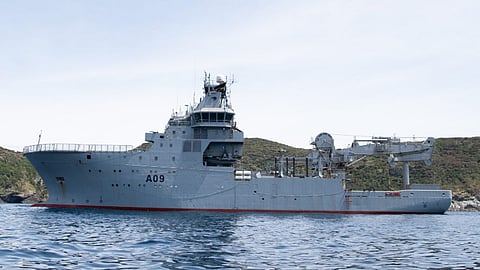OPINION | When naval capability is minimal, it’s also brittle
It is rare for a developed nation’s navy to lose a big vessel in peacetime. The sinking of the Royal New Zealand Navy’s HMNZS Manawanui after it ran aground on a Samoan reef this month—the country’s first naval loss since World War II—has raised important questions about naval preparedness. Fortunately, all 75 crewmembers were rescued, a testament to the ship’s commanding officer and crew.
Although the exact cause of the incident is under investigation, it highlights broader issues about the state of readiness, not just for New Zealand but also for allied and partner navies, including Australia.
This incident underscores several concerning issues about naval preparedness: insufficient naval capability, workforce challenges, budget constraints and the failure to invest in critical enablers. Each is acutely relevant to New Zealand and Australia, highlighting key vulnerabilities.
Manawanui was the only mine warfare and hydrographic survey vessel in the New Zealand fleet, a crucial asset for a maritime nation with the fifth-largest exclusive economic zone in the world. The loss of this ship leaves a glaring gap in New Zealand’s naval capabilities.
New Zealand’s navy, like many smaller ones, has long been operating with minimal capability across several domains. Manawanui’s loss illustrates the risks inherent in this minimalist approach: when one ship is the sole platform for a critical capability, losing it—even temporarily—paralyses that mission set.
This situation should sound alarm bells in Australia as well. The country’s decision to scrap its future mine warfare ship program, alongside the expansion of its at-sea replenishment capabilities in the latest Defence Integrated Investment Program, echoes New Zealand’s dangerous underinvestment in niche but vital capabilities.
The justification for cancelling the mine warfare ship program was that autonomous systems would replace the capability. However, without a ship to deploy from, these systems cannot cover the full spectrum of operations needed to protect Australia’s shipping routes from naval mines—something it should expect in the event of a conflict in the region.
"The failure to maintain and expand these powers now could leave Australia dangerously exposed in the event of a maritime crisis."
During World War II, Australian waters were heavily mined. There were minefields between Sydney and Newcastle, in the Bass Strait, off Hobart and in the Spencer Gulf.
Australia’s hydrographic capability, used for seabed surveys, is in a precarious state, with five of its six ships decommissioned in the past three years and the last likely to follow soon. The 2020 decision to outsource nearly all of the navy’s hydrographic responsibilities has severely weakened its capacity in this area.
Another issue exacerbating the challenges in enabling capabilities is the shortage of Australian replenishment vessels. Both of the Royal Australian Navy’s replenishment ships are out of action until 2025, and while the problems are reportedly being dealt with under the warranties, it raises a broader question: why does Australia have only two? The money allocated to expanding this capability was removed in the latest Defence Integrated Investment Program.
There are many examples of such underinvestment in the navy’s enabling capabilities. The failure to maintain and expand these powers now could leave the country dangerously exposed in the event of a maritime crisis. The underinvestment and lack of preparedness come at a time when Australia’s defence strategy has stopped assuming that the country will get a 10-year warning period of an emerging conflict.
Despite the Australian government’s recent Defence budget uplift in May, the funding allocation, which equates to about 2.1 per cent of GDP, is simply not enough to tackle the issues.
While the figure in nominal terms might be historic, in real terms as a percentage of GDP, it is low—particularly at a time when Defence, and specifically the navy, are going through a major recapitalisation following the underinvestment since the end of the Cold War.
"A conflict in the Indo-Pacific region is no longer a distant hypothetical."
According to the 2024 Australian National Defence Strategy, the country is facing its most challenging strategic environment since World War II. Yet, this has not been met with equally robust investment.
During the Cold War, Australia’s defence spending averaged 2.7 per cent of GDP and was even higher during periods of heightened tension or major recapitalisation. Despite the current strategic environment and the largest defence recapitalisation in decades, defence spending is projected to reach only 2.4 percent of GDP by the end of the decade—well below the Cold War average.
Although funding has been allocated for new surface combatants and submarines, there is little left to enhance other naval capabilities, leaving many of these atrophying and compromising naval preparedness at a critical time.
This inconsistency between our strategic statements about the chances of conflict in the region and our investment is glaring—and our naval preparedness is paying the price.
The sinking of Manawanui should be a wake-up call for Australia and New Zealand. A conflict in the Indo-Pacific region is no longer a distant hypothetical. Regional tensions are rising and our naval forces are likely to be at the forefront of any confrontation.
The ability to prevail in such a conflict depends not just on major warships and submarines but also on the enabling capabilities that underpin maritime operations: replenishment, hydrography, mine warfare and other niche but vital domains.
Article reprinted with permission from the Australian Strategic Policy Institute's analysis and commentary site The Strategist.


